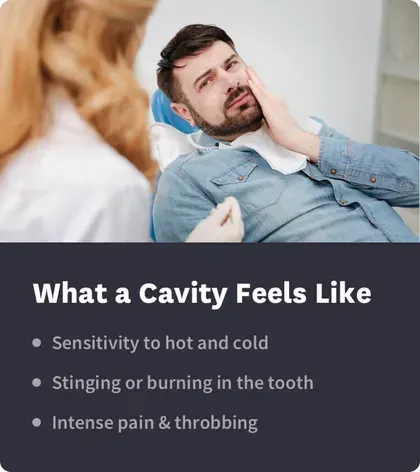Cavity Pain: What Does a Cavity Feel Like? & How to Get Relief

Table of Contents
- Symptoms of Cavity Pain
- Cavity Pain Relief
- Long-Term Pain Relief
- Frequently Asked Questions
- References
Cavities are caused by tooth decay and can cause enough pain to impact daily life. Things such as eating and talking can be tough due to the pain.
Cavities take time to form. Acid comes in contact with the teeth, often through contact with starchy or sugary foods or drinks, and breaks down the natural tooth enamel and minerals.
In the early stages, you may not notice any pain, or you may only have tooth sensitivity to hot and cold. As the cavity progresses, the pain can become more intense and constant.
For quick relief, there are several at-home remedies you can try, including over-the-counter numbing gels and cold compresses. Cavities will need to be filled or treated by a dentist for permanent relief.
Symptoms of Cavity Pain
The first sign of early tooth decay, and a forming cavity, is a white spot that appears on the tooth. This is where minerals have been broken down by regular exposure to acids.

These acids are contained in foods that are high in carbohydrates or sugars. In this early part of the process, the enamel can repair itself naturally. If the tooth decay progresses, however, it leads to a cavity.
Initially, you can feel rough patches on your tooth as the cavity eats at the enamel and causes holes or pits to form that food can get caught in. Stains on your teeth can also occur with tooth decay. These stains can be brown, black, or white.
In the early stages, a cavity can feel like this:
The tooth is sensitive to hot and cold temperatures.
You feel stinging or burning in the tooth.
A toothache comes and goes, but it can be controlled with OTC pain medication.
One side of the mouth is sensitive when chewing food.
As a cavity progresses, symptoms can become more intense and include:
Intense pain, often impacting only one tooth.
Throbbing, burning, pounding, and stinging pain in the tooth.
An aching pain that is unrelenting.
Pain that radiates to the gums, jaw, or ears.
Persistent swelling.
Fever and nausea.
The more a cavity progresses, the worse the pain and symptoms will get. If it isn’t addressed, it can lead to infections and more serious complications.
At times, an abscessed tooth ceases to hurt for some time when the infection kills the nerve or the tooth's pulp.
Immediate Relief for Cavity Pain
There are several things you can do at home before you see the dentist to manage cavity pain.
Limit sugary and starchy foods as well as foods that are extremely high or low in temperature. These can progress cavities and intensify the pain.
Take over-the-counter pain medications, such as ibuprofen (Advil) or acetaminophen (Tylenol), for mild to moderate relief of tooth pain.
Use an oral rinse made of fluoride, hydrogen peroxide, or saltwater. This can help to reduce inflammation, remove bacteria, and offer some immediate relief.
Apply a cold compress. A cold pack to the side of the mouth can relieve pain and help with inflammation in the short term.
Numbing gels and clove oil can help. OTC numbing gels, which often contain cloves, can be applied directly to the tooth for immediate pain relief.
Drink peppermint tea or suck on peppermint, as it can have antioxidant, antibacterial, and numbing properties when applied to an affected tooth.
Keep up with your oral hygiene. Brush and floss regularly to stall the progression of tooth decay and keep foods from being lodged in the hole created by the cavity.
When you go to sleep at night, it can help to prop your head up with a few extra pillows to keep the blood from collecting in the head and increasing swelling.
Cavities can be painful. These at-home methods can help to provide short-term relief and even help to keep cavities from getting worse. When cavities progress and tooth decay sets in, the damage can be permanent. You will need treatment from a dentist for long-term relief.
How to Get Long-Term Pain Relief
Cavities are one of the biggest unmet healthcare needs in the United States. Most adults (90 percent of people ages 20 and older) have experienced at least one cavity.
A cavity can be a nuisance at first and progress into impacting your daily life. It can eventually cause significant pain around the clock, making it hard to proceed with your day-to-day activities. Home remedies can offer some relief in the short term, but the best way to address cavity pain long term is to have it treated by a dentist.
If you are experiencing tooth pain or sensitivity, see your dentist for an exam to determine if you have a cavity. If you do, the dentist will need to remove the part of the tooth that is decayed and then fill it. This is called a filling.
If there is a lot of damage to the structure of the tooth, a crown may be necessary. This is fitted over the tooth to repair it. When the pulp of the tooth is also affected by tooth decay and the nerve dies, a root canal may be needed. This removes and seals the center of the tooth.
Once a tooth has had a filling, crown, or root canal, the pain will dissipate, and the cavity will be fixed. You will usually get relief from your tooth pain once the procedure has healed.
Frequently Asked Questions
Depending on the progression and the level of severity, cavity pain can range from minor discomfort (burning or stinging) to unbearable throbbing and shooting pain. In early stages, you may feel small twinges coming from a specific tooth when you bite down on something hard or if you bite something just in the right position to strike a nerve. But as the cavity grows, you are more likely to feel a sharp pain whenever you eat, talk and sometimes even when the weather is cold.
You can almost always eat if you have a cavity, but your ability to do so depends on how advanced your cavity is and your personal pain tolerance. However, introducing new food and liquids to the infected tooth will only help the cavity’s progression, which in turn will lead to a condition in which you won’t want to eat with that tooth. The sooner you get the cavities professionally looked at, the better your chances of recovery and getting back to normal teeth and mouth functions.
Numerous home remedies have been used over the years to treat cavities. These include sugar-free gum, oil pulling, brushing with fluoride toothpaste and taking vitamin D. The best and most trusted solution is visiting a dentist, who could perform different procedures depending on the progression of the cavity. Fillings are a first line of treatment, surgical removal the last.
